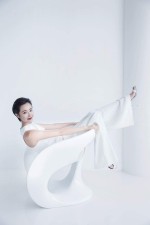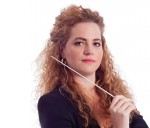Title
Bellini's 1831 opera semiseria La sonnambula is this year's Met+Juilliard co-presentation; it opens on February 9. Speranza Scappucci (Certificate '95, piano; MM '97, accompanying) is returning to lead the Juilliard Orchestra and the singers, who are from Juilliard and from the Metropolitan Opera's Lindemann Young Artist Development Program. David Paul is the dramatic consultant for the concert presentation. Scappucci, Paul, and Lindemann singer and Artist Diploma in Opera Studies student Hyesang Park (MM '15, voice), who sings the role of the sleepwalking Amina (la sonnambula), answered questions about their preparation for the opera.
Body
Were you already familiar with La sonnambula when you were cast?
Hyesang Park: Two of the arias, “Care compagne…Come per me sereno” and “Ah! non credea mirarti,” were part of my competition repertoire, but I'd never done the whole opera. I'd also sung “Ah! non credea mirarti” in a master class with Renée Fleming ('86, voice). She told me that I had too much passion in my voice, but since La sonnambula is a sleepwalker's story, she taught me to sing more beautifully at the same level but without as much passion.
What's your favorite thing about the opera?
HP: When I saw your question, I was so worried about what should I choose—I love everything about the opera! Every note and rhythm and tessitura and grace note makes sense; everything is so meaningful and deep. This is the most perfect opera that Bellini wrote and he really loved it, like we all do. [And the fact that Bellini] gave me a pause before I have to sing a very, very high note or have a big emotion—at first I thought it was so kind of him, but then I realized that the pauses aren't only for me, they have a reason: When Elvino rejects me (Amina), I lose my words and can't speak. That's why Bellini put a long pause before “Ah! non credea mirarti.”
What has been the most challenging aspect of preparing this role?
HP: To be in that character was hard. My voice is very warm, but Amina should be a more calm and quiet person though at the same time strong. When I perform a role, I prepare like an actor and try to be that person in real life. [To prepare for this role] I haven't had dates or a drink; I'm getting very calm and quiet and not so open to other people. I think only about Amina's character, and it's very challenging. I have to stay this way until February and then I'll turn to another part of Hyesang!
What do you feel are the most challenging aspects of La sonnambula?
Speranza Scappucci: It's an extremely difficult score. At first sight, the music seems “simple,” especially the orchestral part. Often in this piece, the orchestra is treated like mere accompaniment to the voices, which apparently have the hardest tasks. But in reality the orchestra is full of nuances and the so-called accompaniments are strictly linked to the vocal line. What might seem to be just an oompah-oompah figure is in reality very expressive and has to be phrased sensibly. The recitativi are the hardest to understand musically—there has to be complete unity between the vocal line and the orchestra and chorus!
Why is this opera a good choice for the Met+Juilliard collaboration?
SS: La sonnambula appears often on the calendars of the greatest opera houses in the world, including the Met! I think it's a brilliant idea to expose the young talented singers of Juilliard and the Lindemann program to this challenging music and at the same time to expose the Juilliard Orchestra (which has some of the finest young musicians of the future generation) to this music that some of them will play with the greatest orchestras of the world one day. It's for their future.
Many stylistic traditions have grown up around an iconic piece like this. How do you respond to these traditions as they relate to the printed score?
SS: My principal duty as a conductor is to always go to the score and try to understand it the way the composer wrote it. I am convinced that if Bellini wrote this score, or Norma, in a certain way he must have had his dramatic reasons. Every note has a meaning. This doesn't mean that some of the traditions that have come through the years are wrong. One has to be open to analyze those too. And if musically they make sense, why not? If they are against the music or the dramaturgy of a particular moment, then I am all for doing what the composer wrote. These people were geniuses—who are we to decide we can do it better?
To hear more of Scappucci's take on this, check out her Juilliard Snapshot.
What are the challenges in working with this opera?
David Paul: La sonnambula, aside from the extreme vocal demands, is most challenging for the singers from a stylistic perspective, as it's a crown jewel of bel canto style. From a narrative and emotional perspective, bel canto demands an extremely high level of focus and detail; every note, run, and cadenza—whether it's jubilant or heartbroken—must be full of deep feeling and expression. The emotional range required by this piece is particularly large: We begin with Amina anticipating her wedding day, the happiest day of her life, only to have all of that taken away from her within a matter of minutes. Nothing is deadlier for bel canto opera than performers going on autopilot, so our greatest challenge will be to work in great detail and for the singers to maintain and sustain that detail in performance.
Presumably it can be harder to convey aspects of the opera in a concert presentation—are there any tricks of the trade that you can share with us?
DP: We have a particular challenge with La sonnambula as the singers will remain close to each other, the orchestra, and the conductor for the whole performance. That's in contrast to last year's Iphigénie, which was fully staged. Therefore, our focus will be on specific emotional detail, and keeping the dramatic suspense intact by connecting every moment with the following one. We will use lighting to support precisely the story told through the music and the words, and to, quite literally, shine a light on the emotional journey and struggle of these young protagonists. Beyond that, we hope the music will captivate the audience and inspire them to imagine and feel what they cannot see.







